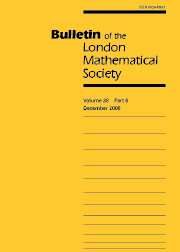No CrossRef data available.
Article contents
KUNIHIKO KODAIRA
Published online by Cambridge University Press: 01 July 1999
Abstract
Kunihiko Kodaira, who died on 26 July 1997, was the outstanding Japanese mathematician of the post-war period, his fame established by the award of the Fields Medal at the Amsterdam Congress in 1954.
He was born on 16 March 1915, the son of an agricultural scientist who at one time was Vice Minister of Agriculture in the Japanese Government and had also played an active role in agricultural developments in South America. Kodaira studied at Tokyo University, taking degrees in both mathematics and physics. From 1944 to 1951 he was an associate professor of physics at the University. His PhD thesis was published in the Annals of Mathematics [18], and it immediately attracted international attention. Essentially this filled a significant lacuna in the basic theorem of W. V. D. Hodge on harmonic integrals. Kodaira had worked on this for many years but, because of the war, his research was carried out in isolation from the international community and did not become known until much later.
Hermann Weyl, who had been a keen supporter of Hodge's work, realised the importance of Kodaira's thesis, and arranged for him to come to the Institute for Advanced Study in Princeton in 1949. This was the start of Kodaira's 18-year residence in the United States, a fruitful period which saw the full blossoming of his research, much of it in collaboration with Donald Spencer. Kodaira spent many years at Princeton, divided between the Institute and the University, but the years 1961–67 were more unsettled, seeing him successively at Harvard, Johns Hopkins and finally Stanford. In 1967 he returned to a professorship at the University of Tokyo, where he remained until the normal retiring age. From 1975 to 1985 he worked at Gakushuin University, where retirement restrictions did not apply.
- Type
- OBITUARY
- Information
- Copyright
- © The London Mathematical Society 1999




